Physical Address
304 North Cardinal St.
Dorchester Center, MA 02124
A thorough history and physical examination are crucial. History of nasal trauma, prior surgery, airway complaints, and allergies are carefully recorded.
Three-dimensional evaluation, as well as cephalometric analysis of life-size photographs, is performed in order to evaluate the location and severity of asymmetry.
A detailed evaluation of the upper nose (nasal bones and upper lateral cartilages [ULC]), septum, lower lateral cartilages, anterior nasal spine, and medial crural footplates will provide an accurate assessment of asymmetry.
It is important to use the intercanthal midline as the reference point rather than the inter-eyebrows midline since most patients differentially pluck their eyebrows to camouflage the nasal asymmetry.
The open rhinoplasty is the preferred approach for correction of the deviated nose. It provides the widest exposure and the best opportunity to anatomically realign the deviated structures.
A rare unilateral nasal bone asymmetry can be corrected with an onlay graft, but it is not the optimal choice.
The mid-vault deviation is invariably associated with a septal deviation, and a successful correction will require a problem-oriented septoplasty.
When correcting the deviated mid-vault, it is always necessary to separate the ULC from the septum.
The ULC should not be trimmed until the nasal bones have been repositioned.
Deviation of the caudal third of the dorsum may require a septal rotation suture.
Deviation of the base of the nose is invariably associated with asymmetric lower lateral cartilages, the correction of which is essential to a successful elimination of asymmetry from this part of the nose.
Another integral component of the caudal nasal deviation is the dislodgement of the cartilaginous septum to one side of the vomer bone. Removal of the redundant and overlapping portion of the cartilage is paramount to the straightening of the columella and the base of the nose.
Long-standing deviation of the septum to one side is invariably associated with enlargement of the opposing inferior and sometimes the middle turbinate.
Access video lecture content for this chapter online at Elsevier eBooks+ ![]()
Difficulty breathing through the nose can be due to mechanical or dynamic reasons. The rhinoplasty surgeon's understanding of the anatomy and physiology of the nasal airway and the various causes of obstruction are vital to making the correct diagnosis and providing the appropriate management. The most common treatment modality in this situation often involves submucous resection of the septum and/or inferior turbinates. Despite being the correct choice in some situations, the decision to perform such procedures should be based upon a careful analysis of the findings. In addition, the etiology of most nasal airway obstruction is not structural deviation. In these scenarios, it is an inflammatory obstruction that is amenable to medical management. Prudent assessment of the pathology causing the nasal obstruction and sensible choice of treatment will often lead to successful correction of a challenging problem.
Specific anatomy, as it relates to the airway, can be organized into soft-tissue and osseocartilaginous categories. Although less commonly involved in nasal airway disorders, the soft-tissue envelope with its underlying perinasal musculature plays a vital role in maintaining the patency of the valvular mechanism.
The perinasal musculature can be divided into an intrinsic (having both origin and insertion within the perinasal area) and an extrinsic group containing three paired muscles.
The intrinsic group includes the procerus, which elevates the dorsum and lowers the lateral cartilages. Its distal aponeurosis blends with the pars transversa of the nasalis muscle to form the superficial musculo-aponeurotic system of the nose. The pars transversa provides lateral wall stability and can also be a dilator. The primary dilatory muscle of the ala is the pars alaris and is responsible for alar flaring. In contrast, the depressor alae or myrtiforme muscle, which originates from the border of the pyriform crest and then rises vertically like a fan up to the ala, acts as a depressor and constrictor of the nostrils. Release of this muscle during alar base surgery has a beneficial effect on the external valve.
The three paired muscles of the extrinsic group include the levator labii superioris alaeque nasi, zygomaticus minor, and the orbicularis oris. Of these, the levator labii superioris alaeque nasi is the most important dilator with the zygomaticus minor providing lateral wall stability ( Fig. 21.1 ).
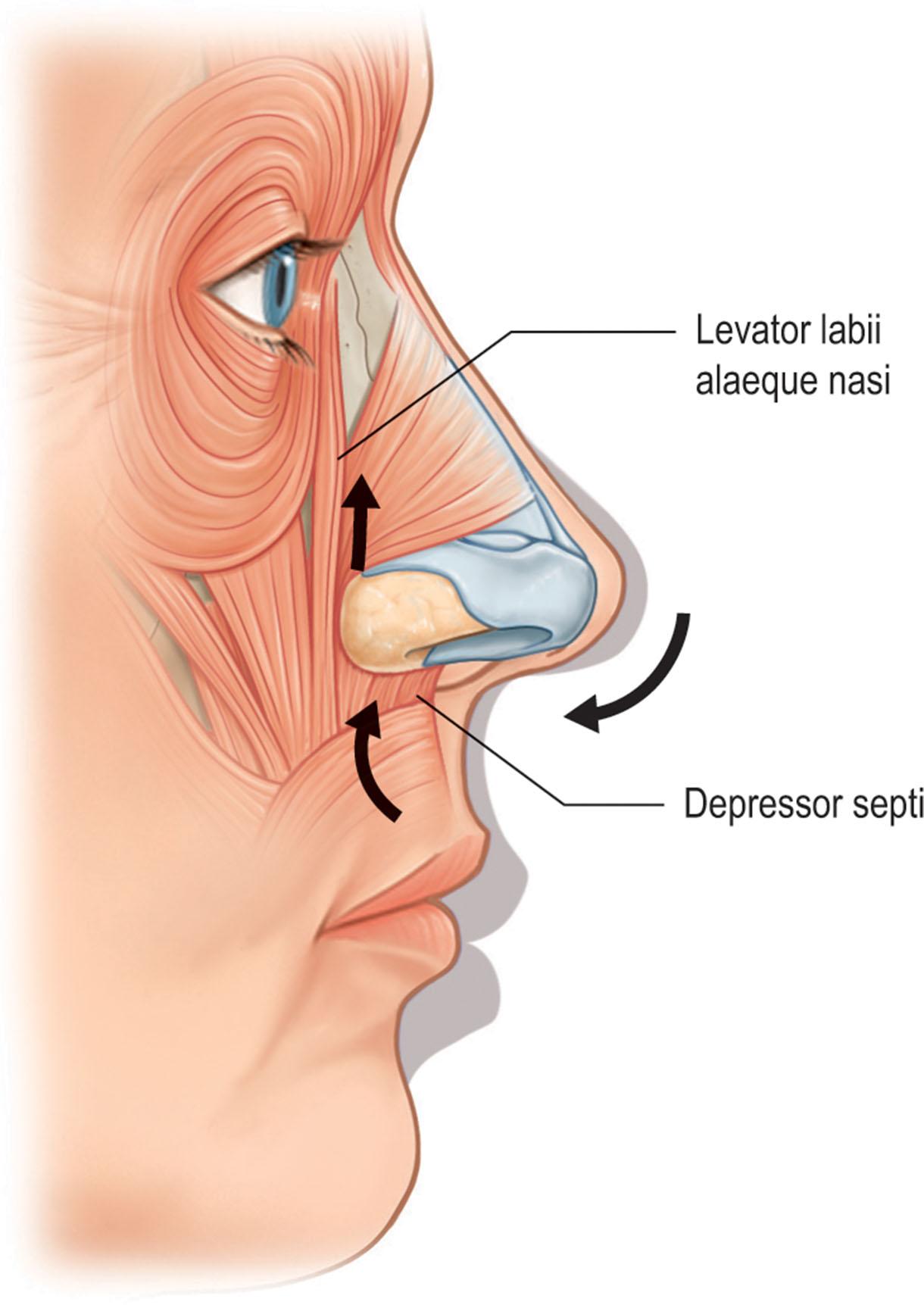
Other soft-tissue components involved in airway competence are the nasal alae. Although devoid of cartilage, they are composed of a fibrofatty areolar tissue which is lined by epithelium internally and externally. Collapse of these structures will lead to an airway obstruction.
When considering the structures of the osseocartilaginous vault, the most important central support for the nose is the septum ( Fig. 21.2 ). The perpendicular plate of the ethmoid articulates with the posterior edge of the quadrangular (septal) cartilage, and both structures articulate with the vomer posteriorly. The vomer then lays directly on the maxillary crest. The anterior-caudal portion of the septal cartilage also rests on the maxillary crest, however, in a tongue-and-groove relationship. This point of articulation is unique in that the perichondrium of the cartilage is only partially contiguous with the periosteum of the crest allowing a decussation of fibers that joins the contralateral perichondrium. This crossed configuration can make a seamless submucoperichondrial dissection less than facile. It also lends this portion of the septum susceptible to post-traumatic displacement out of the groove of the crest.
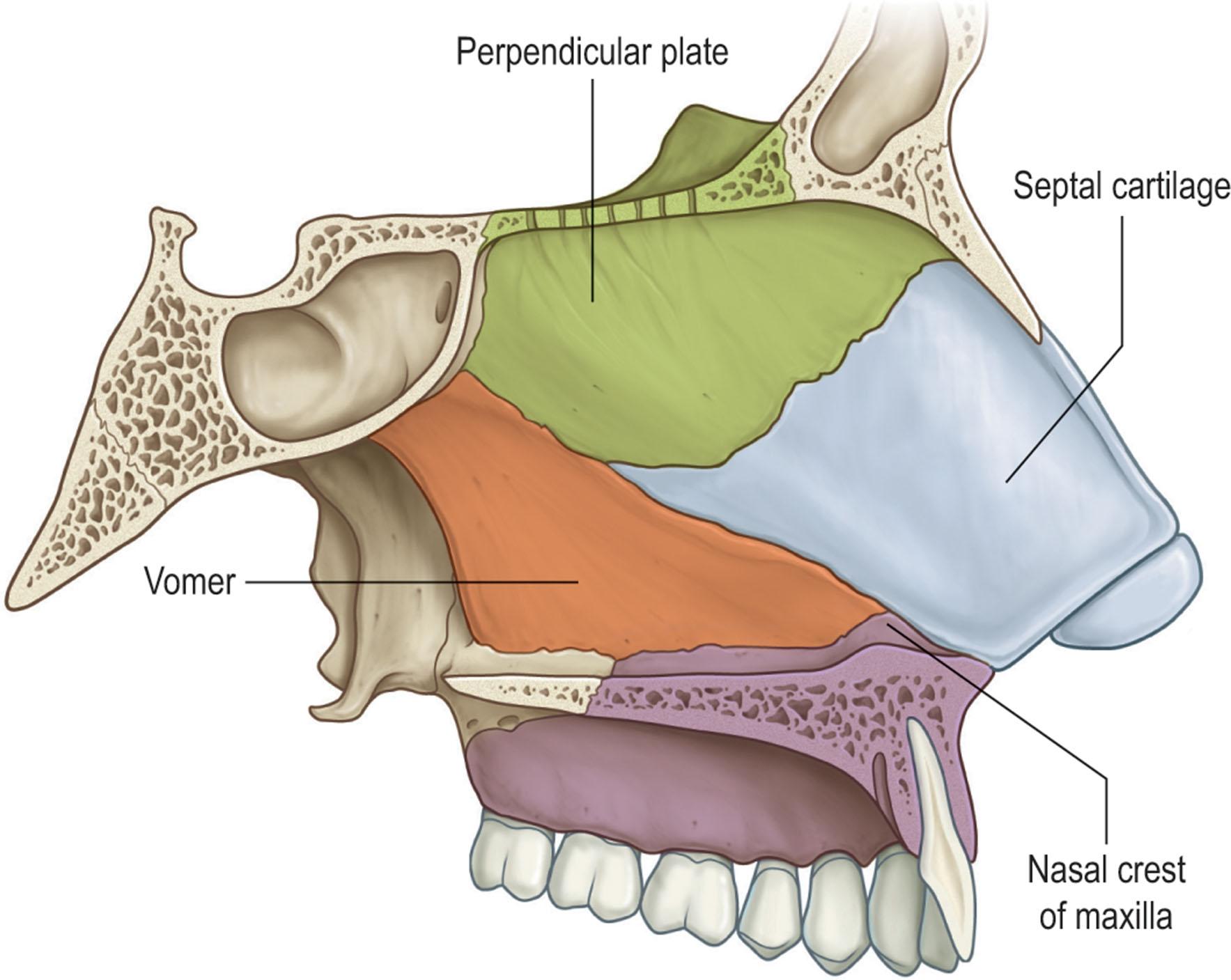
The upper and lower lateral cartilages also play a significant role in nasal support. The point at which the caudal margin of the upper lateral cartilages (ULC) and the cephalic rim of the lower lateral cartilages overlap is defined as the scroll area. Cartilaginous overlap in this region has been shown to enhance support at this level. Superiorly, another area of overlap occurs at the junction between the cephalic ULC and the nasal bones. This makes up the keystone area and is characterized by a firm adherence between these structures. Subsequently, trauma to the nasal bones can shift this entire unit. In addition, the ULC are fused to the septum in the mid-vault region and separate as one moves caudally. This is clinically important during placement of spreader grafts, as this region will require sharp dissection to release the upper lateral cartilage from the septum.
Although not of structural significance, the inferior turbinate occupies a large portion of the nasal airway and can account for up to two-thirds of the total airway resistance. It is composed of dense lamellar bone taking origin from the medial wall of the maxilla bilaterally. The turbinates are covered with an erectile mucosal tissue composed of pseudostratified ciliated columnar epithelium. The submucosa contains large quantities of seromucinous glands and vascular channels containing cavernous sinusoids. These channels are under the influence of the autonomic nervous system and thus serve as the end target for decongestant medication. The sympathetic system regulates the resistance vessels (and therefore blood flow), and the parasympathetic system regulates the capacitance vessels (and therefore blood volume) of the nasal mucosa. The submucosa also contains large numbers of mast cells, eosinophils, plasma cells, lymphocytes, and macrophages. Thus, chronic inflammation, secondary to stimulation of these abundant proinflammatory cellular constituents, can lead to fibrous deposition and chronic hypertrophy of the turbinate.
The internal nasal valve accounts for approximately 50% of the total airway resistance and is the narrowest segment of the nasal airway. It is formed by the angle between the junction of the nasal septum and the caudal margin of the upper lateral cartilage and is typically 10–15° ( Fig. 21.3 ).
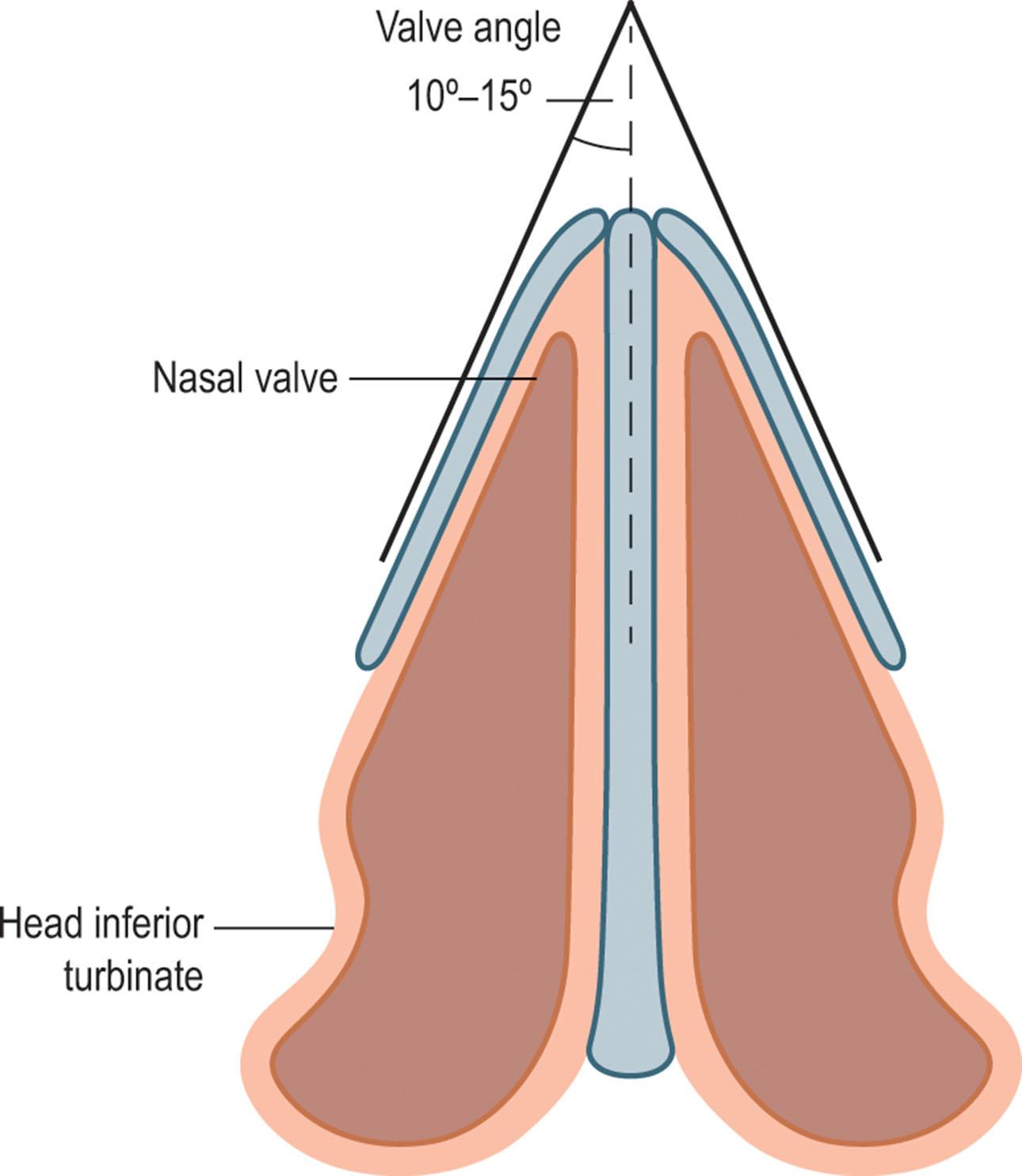
The external nasal valve is formed by the caudal edge of the lateral crus of the lower lateral cartilage, the soft tissue alae, the membranous septum, and the sill of the nostril and serves as the entrance to the nose. This is an occasional site of obstruction secondary to extrinsic factors, such as foreign bodies, or intrinsic factors, such as weak or collapsed lower lateral cartilages, a loss of vestibular skin, or cicatricial narrowing ( Fig. 21.4 ).
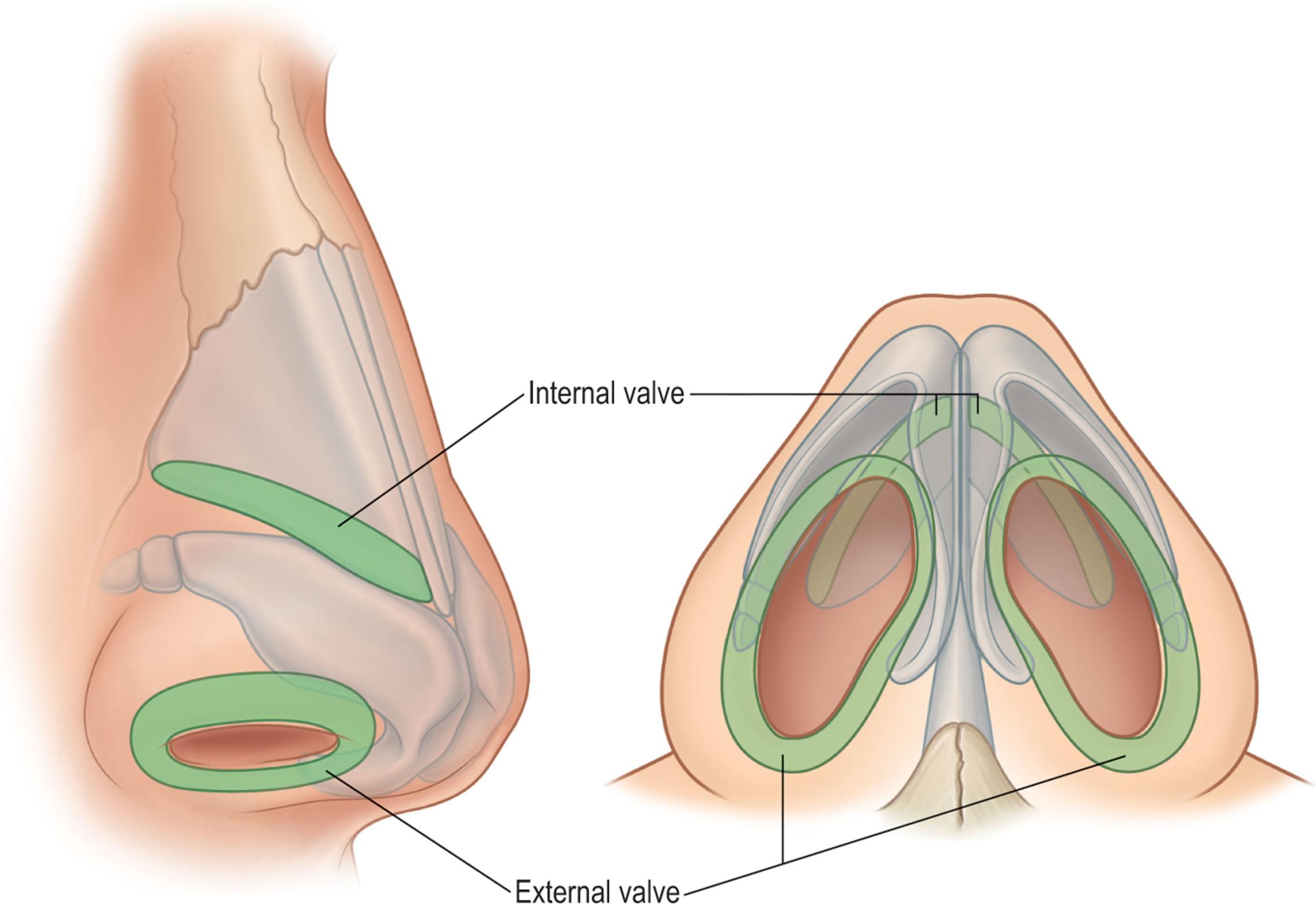
As described in Eugene Courtiss et al .'s overview on nasal physiology, the nose has seven basic functions: respiration, temperature regulation, humidification, particulate filtration, olfaction, phonation, and as a secondary sex organ. The most vital of these functions is respiration and can be described using some basic laws of physics.
When there is a pressure differential between the external nasal vestibule and the nasopharynx, a gradient is formed and air flows through the nose. Thus, an increase in nasal resistance (decreases in nasal airflow) can result from such structural limitations as hypertrophied turbinates, septal deviations, valve incompetence, or intranasal masses. The magnitude of nasal airway resistance cannot be underestimated and, in fact, is responsible for approximately half of the total respiratory tree resistance.
Bernoulli's principle defines flow through a tubular structure such that the flow at the two ends is constant. In addition, areas of constriction increase flow and areas of dilation decrease flow. In these areas of increased flow, the pressure is decreased and vice versa in areas of decreased flow. This becomes clinically evident in the incompetent internal or external nasal valve. Because these are areas of narrowing/constriction, airflow is increased at the level of the valve, leading to a decrease in pressure. This effectively generates a collapsing force on the valves and is exacerbated upon heavy inspiration or sniffing.
Bernoulli's principle can be mathematically substantiated using Poiseuille's law. This law provides that flow is directly proportional to the difference in pressure multiplied by the radius raised to the fourth power and inversely proportional to the length of the tube.
This demonstrates that the longer the tube (nose), the less the flow. Even more dramatic is that a minimal increase in the size of the tube causes an exponential (r 4 ) increase in flow. This has clinical implications as the cross-sectional area varies throughout the nose. It is narrowest at the internal nasal valve, larger at the level of the mid-turbinates, and largest at the level of the posterior choanae. As a result, minimal changes at the level of the internal nasal valve can have profound changes on nasal airflow and are subsequently cited as the most common cause of nasal airway obstruction.
An understanding of laminar and turbulent flow is also essential to a complete understanding of respiration and nasal airflow physiology and dynamics. When laminar flow exists, air moves through a straight tube in a predictable fashion. Air near the walls of the tube is virtually still, whereas flow in the center moves rapidly. This is in contrast to turbulent flow, where the airflow follows a random path and forms eddy currents and whorls. To overcome turbulence, a greater pressure gradient must be generated. In other words, the less laminar the airflow, the higher the resistance and the lower the airflow. For example, during quiet respiration where pressures are low and under 1.5 cm of water, nasal airflow is considered to be laminar. During inspiration, the main airflow is directed through the middle meatus with a smaller amount coursing through the inferior meatus and an even smaller amount up toward the cribriform plates.
Finally, another less well understood factor in nasal airflow is the nasal cycle (cycle of Minz). Approximately 80% of the population experiences cyclical swelling and contraction of the nasal mucosa. While one airway is enlarging, the other is constricting. The process requires 30 min to 5 h to complete, and total airflow and resistance remains constant throughout this period.
The physiologic nasal regulatory system is so efficient that inspired air is heated almost to body temperature before it even reaches the larynx. Even air at temperatures of −5°C is brought to between 31°C and 37°C. This function typically requires 70–100 calories per day.
Regardless of the ambient temperature or humidity, approximately 90% humidification is achieved during inspiration before the air reaches the lungs. This requires 1 liter (L) of water per day. A small amount of this water is recovered during exhalation secondary to cooling of the exhaled air; however, a net balance of −250 mL to −500 mL per day still exists.
Four mechanisms have been described by which the nasal cavity achieves adequate filtration of inspired air. These include impingement, electrostatic charge, vibrissae, and the mucociliary blanket. Impingement is a phenomenon that occurs when particles suspended in a gas become deposited on the walls of a tube downstream from a bend or constriction. Two such bends exist within the nasal cavity: the internal nasal valve, where the airflow is changed from a column into a sheet, and at the posterior nasopharynx, where the airflow is sharply deflected inferiorly. These two anatomic impingement points are responsible for the deposition/filtration of 85–90% of particulate matter ≥5 µm. The electrostatic charge of the walls of the nasal cavity is positive and produced by the mucociliary blanket. Thus, the negatively charged inspired foreign particles are attracted to the nasal walls and prevented from traveling distally to more sensitive areas of the respiratory tract. Larger particles are trapped within the vibrissae, which are found just within the nasal vestibule. The mucociliary blanket is composed of two layers: the deeper layer is thinner and less viscous and surrounds the cilia, while the superficial layer is thicker and more viscous and houses the cilia tips. As a whole, the mucociliary blanket is a thin, sticky, adhesive sheet with a pH slightly more acidic than serum. It is produced by serous and mucous glands and by the goblet cells of the mucosa at a rate of about 250 mL per day. This blanket ultimately functions, in a rhythmic fashion, to sweep particulate matter to the posterior nasopharynx.
Olfaction clearly enhances our sense of taste and aids in memory association. It may also play a protective role by warning of potential environmental dangers when noxious odors are perceived. Causes for an olfactory disturbance are many and include infection, trauma, mechanical obstruction, endocrine disorders, and medications, to mention a few. In addition, nasal septal surgery can infrequently lead to anosmia; fortunately, this is most often temporary.
It is well known that the voice is produced via vibrations of the vocal cords with the passage of air. However, the quality of the voice depends on the resonance of air through the mouth, pharynx, and nose. As a resonance chamber, the nose is a necessary component in the formation of certain vowels and consonants alike. Patients may therefore ask if nasal surgery will alter the sound of their voice. To that end, they can be counseled that postsurgical changes in the sound of one's voice have not been substantiated. Septal perforations, however, change airflow resistance and thus may change voice quality and/or create a nasal whistle with inspiration.
It has been known for some time that mucosal engorgement occurs during sexual arousal. A relatively recent discovery in nasal physiology is the vomeronasal organ (Jacobson's organ, Ruysch tube). It is composed of bilateral blind ducts in the mucosa of the anterior third of the human septum. Their role is not fully understood, but it is felt that they play a part in reproductive behavior by acting as pheromone chemosensory receptors. The external opening of the ducts can be found in the septal mucosa just posterior to the columellar base and 1 mm above the maxillary groove.
Correction of the deviated nose remains one of the more challenging aspects for the rhinoplasty surgeon. Not only is the deviated nose an aesthetic concern, but it is also of functional consequence as well. Debate continues as to the optimal approach. Anatomic reconstruction will provide a return to normal anatomy at the risk of decreasing structural support of the osseocartilaginous framework. Camouflage techniques may provide a simpler solution to provide symmetry; however, functional defects are denied correction.
Many of the pioneers of modern rhinoplasty techniques recognized the importance of the septum, internal and external nasal valves, and the turbinates in the etiology and subsequent surgical approaches to the deviated nose. This understanding has become the cornerstone to the reconstruction and functional restoration of the deviated nose. However, the anatomic deviation and thus, functional obstruction, may be at the bony pyramid, the upper lateral cartilages, the lower lateral cartilages, the septum, nasal valves, turbinates, or any combination of these entities. The ultimate goal is to provide a consistent, stable long-term correction that is both aesthetically pleasing and functionally sound, and this can only be expected through correction of all these abnormalities.
With an understanding of the nasal airway anatomy and physiology, one can more easily begin to identify potential sites of obstruction and/or deviation. Although many causes of nasal airway obstruction are “anatomic” in nature, and thus amenable to surgical correction, medical reasons for obstruction cannot be overlooked. Surgical intervention in these instances would be a disservice to the patient. Thus, there may be more than one etiology and therefore more than one line of treatment. This section focuses on the various etiologies for nasal airway obstruction, with their respective treatment recommendations to follow.
Rhinitis can be the result of a number of different causes, including infectious, allergic, vasomotor, atrophic, rhinitis medicamentosa, postoperative, hypertrophic, and miscellaneous. It has even been cited as the number one cause of nasal obstruction.
Infectious rhinitis is the most common type and presents in two forms: viral and bacterial. Viral rhinitis is more common than bacterial etiologies and is usually the result of the rhinovirus. Bacterial rhinitis is mostly caused by Gram-positive isolates. Regardless of the etiology (viral or bacterial), there is significant mucosal edema during infection, and this can last for several weeks leading to a narrowed nasal airway with subsequent obstruction.
Allergic rhinitis is said to have a prevalence of between 14% and 31% in the US alone. True allergic rhinitis is mediated by immunoglobulin E in response to an antigen–antibody reaction. This most commonly presents in a seasonal form from environmental factors such as an air-borne pollen or spore. Associated symptoms include sneezing, urticaria, and mucosal swelling.
Vasomotor rhinitis arises when the balance between the sympathetic and parasympathetic nervous systems is disrupted, such that the parasympathetic system is hyperactive. This leads to copious amounts of watery rhinorrhea and mucosal congestion. Although most commonly idiopathic in nature, other potential causes include pregnancy and endocrine and emotional disorders.
Atrophic rhinitis is a rare condition with its typical onset in puberty and characterized by a slow, progressive atrophy of the nasal mucosa. This results in crusting and often foul-smelling drainage. Several organisms have been isolated from patients affected by this condition; however, their exact mechanism in the pathogenesis remains unclear. A subcategory of atrophic rhinitis is “empty nose syndrome”. This is a poorly understood and highly debated iatrogenic disorder that results from the destruction of normal nasal tissue, specifically the turbinates. The most commonly reported symptoms include a paradoxical nasal obstruction and feeling of intranasal fullness.
Rhinitis medicamentosa (RM) occurs frequently in patients who present with nasal airway obstruction. It is seen with prolonged use of sympathetic agonists such as Afrin or Neo-Synephrine and leads to a rebound phenomenon of mucosal engorgement and profuse rhinorrhea. Patients often try increasing both the dose and the frequency of nasal sprays upon the onset of RM, worsening the condition. The swelling of the nasal passages caused by rebound congestion may eventually result in permanent turbinate hyperplasia.
Postoperative rhinitis or symptoms of nasal obstruction invariably affect virtually all patients after rhinoplasty. This is usually a result of normal postoperative mucosal edema and/or crusting within the nasal cavity. In addition, patients who present with preoperative allergic rhinitis or vasomotor rhinitis may experience a postoperative “flare” and should be counseled as such prior to surgery.
Hypertrophic rhinitis results from chronic mucosal inflammation and can stem from any of the aforementioned types of rhinitis. This chronic inflammation ultimately leads to turbinate hypertrophy, most commonly the inferior turbinate. As would be expected, this is a major cause of nasal airway obstruction.
Miscellaneous causes of rhinitis may include such medications as oral contraceptives, antihypertensives (beta-blockers), and antidepressants. Other causes include Wegener's granulomatosis, polymorphic reticulosis, cystic fibrosis, syphilis, hypothyroidism, and poorly regulated diabetes.
The septum and the nasal bones control the direction of the nose, and thus deviation of the nose can result from malalignment of one or the other or a combination of both. Often, the nasal bones follow the direction of the deviated septum; however, these structures may move independently. Mid-vault deviation consistently accompanies at least anterior and commonly mid and posterior septal deviation. Deviation of the lower nose may involve the caudal septum, anterior nasal spine, and lower lateral cartilages. In all types of septal deviation, the middle and/or inferior turbinates may be enlarged. The enlargement is usually juxtaposed to the concave side of the septum. Previous studies have detailed and categorized the types of septal deviation.
There are six classes of septal deviation:
The most common type is a septal tilt in which the septum itself has no significant underlying curvature, but is tilted to one side. In most cases of septal tilt, the internal deviation of the septum is to the left and the external deviation of the nose is to the right. This is usually accompanied by an enlargement of the inferior turbinate ipsilateral to the external deviation ( Fig. 21.5 ).
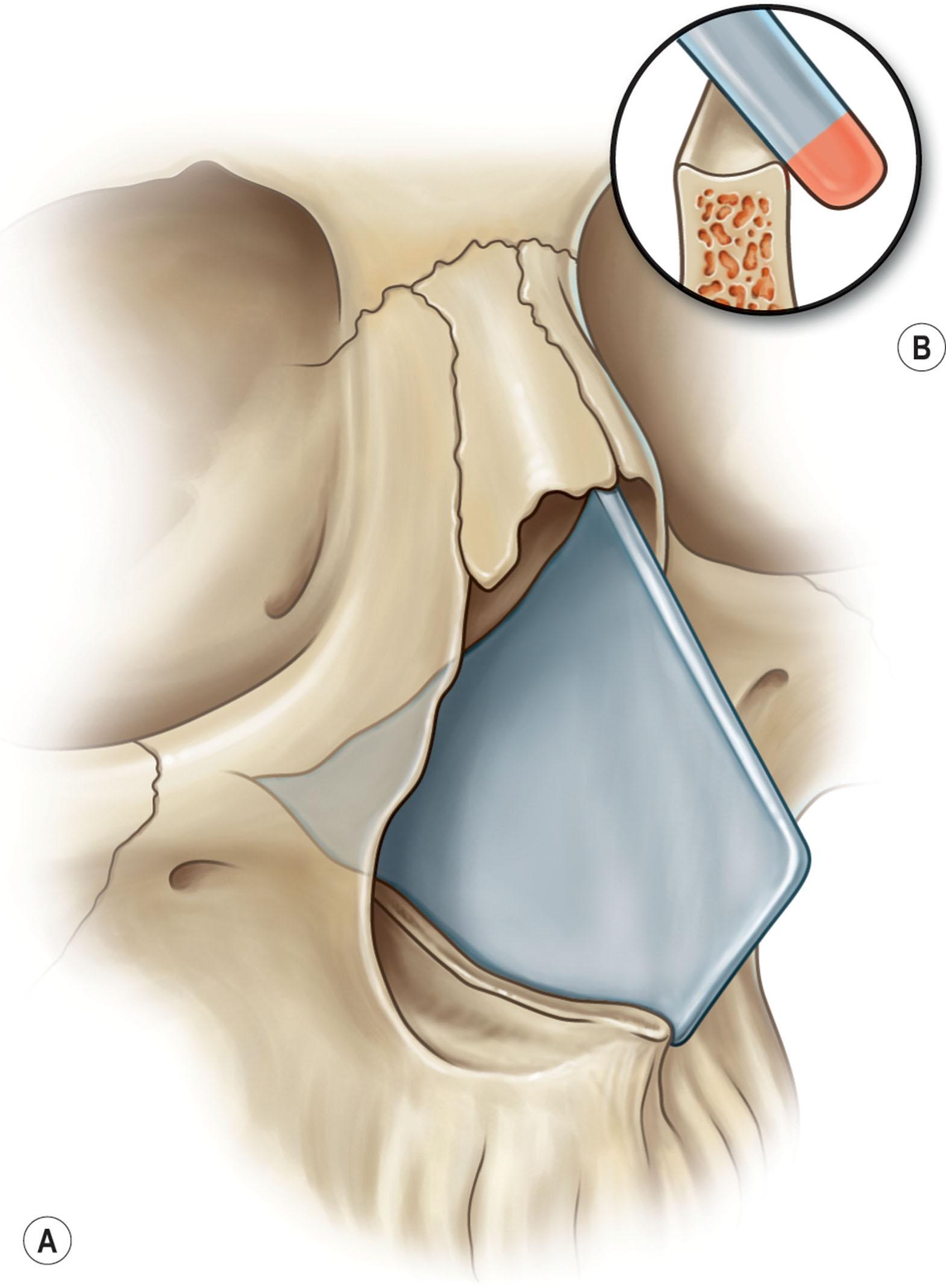
C-shaped anteroposterior deviation is usually associated with deviation of the vomerine plate. External reflection of the anteroposterior C deviation is often similar to the septal tilt. The middle turbinate is often enlarged as well ( Fig. 21.6A ).
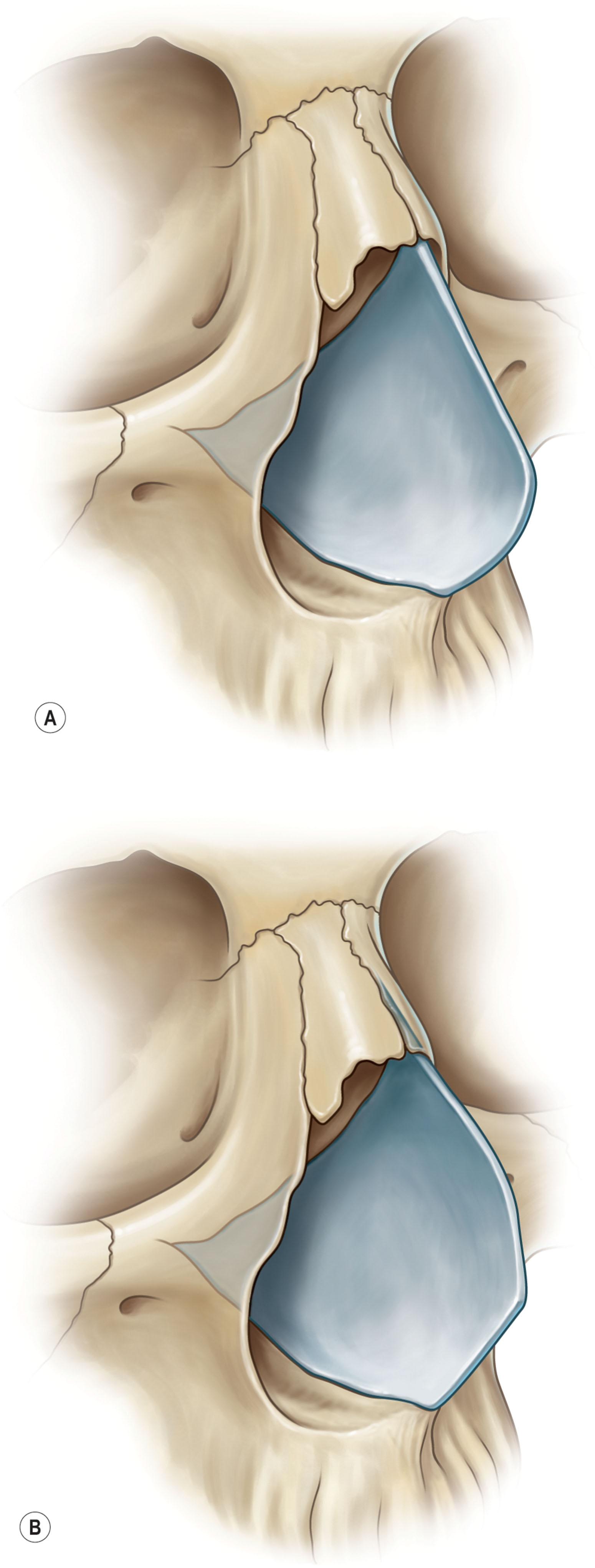
C-shaped cephalocaudal deviation presents externally as a C-shaped appearance of the nose. In reality, the most common form of this deviation is the reverse C with the curve facing the patient's right. The opposing inferior and often the middle turbinates are enlarged (see Fig. 21.6B ).
S-shaped anteroposterior deviation is defined by two curvatures next to each other, in opposing directions. Externally, the anteroposterior deviation will present with a shift of the nose to one side ( Fig. 21.7A ).
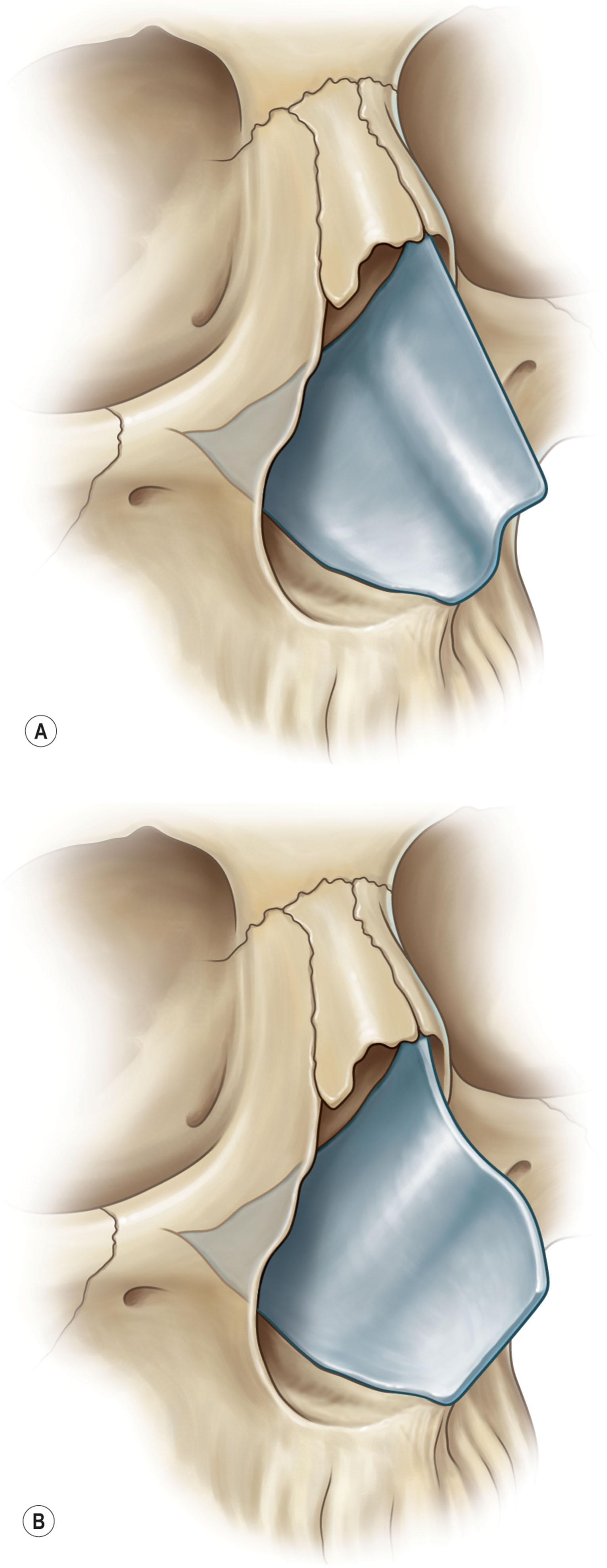
S-shaped cephalocaudal deviation is similar to the previous type except that the curvatures combine to form an S-shape in the cephalic to caudal direction. Turbinate enlargement is common with both types of S-shaped deviations (see Fig. 21.7B ).
The last type of septal deviation is a localized deviation or spur. This is a purely functional problem and has no translation to external shape of the nose. Turbinate enlargement is not common with this type of deviation.
Additionally, the deviation could be in the anterior septum or in the tip, related to the structural asymmetry of the lower lateral cartilages, either one being short or the other being too long.
The importance of functioning nasal valves in nasal airflow cannot be understated, and they have been studied extensively. The internal nasal valve is a crucial regulator of nasal airflow dynamics and should be preserved and/or reconstructed when performing rhinoplasty. Injury and destabilization of this complex, either from surgery or trauma, may result in collapse and subsequent nasal airway obstruction. For example, in patients undergoing dorsal hump reduction, great care must be taken when separating the ULC and mucosa from the septum as loss of medial support can cause an inverted-V deformity. This effectively narrows the internal nasal valve. In addition, scar tissue may obscure the normal 10–15°angle or cause obstruction by cicatrix or mass effect.
Normal function of this valve depends on the structural integrity of the lower lateral cartilages, perinasal musculature, and adequate soft-tissue coverage. Functional compromise is seen with encroachment of the nasal spine, and especially the footplates, into the nostril opening. Architecturally weak lateral crura further compound the effects of a widened columella. Other causes for external valve collapse include facial nerve palsy, pinched ala deformity, and postsurgical vestibular stenosis secondary to synechiae and over-resection of the lower lateral cartilages.
Become a Clinical Tree membership for Full access and enjoy Unlimited articles
If you are a member. Log in here